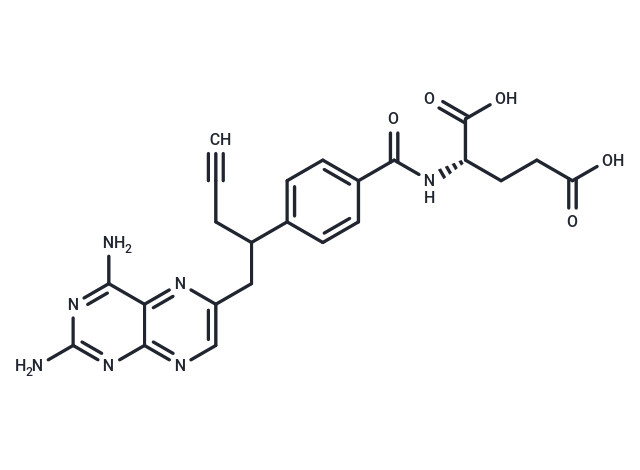Shopping Cart
- Remove All
 Your shopping cart is currently empty
Your shopping cart is currently empty

Pralatrexate (10-Propargyl-10-deazaaminopterin) is a folate analogue inhibitor of dihydrofolate reductase (DHFR) exhibiting high affinity for reduced folate carrier-1 (RFC-1) with antineoplastic and immunosuppressive activities.

| Pack Size | Price | Availability | Quantity |
|---|---|---|---|
| 1 mg | $30 | In Stock | |
| 2 mg | $44 | In Stock | |
| 5 mg | $68 | In Stock | |
| 10 mg | $117 | In Stock | |
| 25 mg | $172 | In Stock | |
| 50 mg | $207 | In Stock | |
| 100 mg | $369 | In Stock | |
| 1 mL x 10 mM (in DMSO) | $72 | In Stock |
| Description | Pralatrexate (10-Propargyl-10-deazaaminopterin) is a folate analogue inhibitor of dihydrofolate reductase (DHFR) exhibiting high affinity for reduced folate carrier-1 (RFC-1) with antineoplastic and immunosuppressive activities. |
| Targets&IC50 | Axl (KPL-4 cells):0.16 μM, Axl (SUM149 cells):0.43 μM |
| In vitro | Pralatrexate and bortezomib exhibits concentration- and time-dependent cytotoxicity against a broad panel of T-lymphoma cell lines. Pralatrexate shows synergism when combined with bortezomib in all cell lines studied. Pralatrexate also induces potent apoptosis and caspase activation when combined with bortezomib across the panel. Pralatrexate significantly modulates the expression of p27, NOXA, HH3, and RFC-1 as assessed by Western blot assays. [1] Pralatrexate is rationally designed for improved cellular transport via RFC-1, and to have greater intracellular drug retention through the enhanced formation of polyglutamylated conjugates. Pralatrexate is thought to exert its pharmacological effect primarily through inhibition of DHFR, having an IC50 in the picomolar range. [2] Pralatrexate demonstrates superior intracellular transport via the reduced folate carrier, and increased accumulation within cells by enhanced polyglutamylation. Pralatrexate exhibits antitumor activity that is superior to the activity of other antifolates. [3] Pralatrexate's enhanced activity relative to methotrexate (MTX) is due to its much more rapid rate of transport and polyglutamation, the former less important when the carrier is saturated. [4] |
| In vivo | Pralatrexate treatment results in treatment-related toxicity in MV522 mice models, as determined by significant weight loss in some animals prior to death; however, remaining mice regains all lost weight by Day 35. [2] |
| Alias | Folotyn, 10-Propargyl-10-deazaaminopterin |
| Molecular Weight | 477.47 |
| Formula | C23H23N7O5 |
| Cas No. | 146464-95-1 |
| Smiles | Nc1nc(N)c2nc(CC(CC#C)c3ccc(cc3)C(=O)N[C@@H](CCC(O)=O)C(O)=O)cnc2n1 |
| Relative Density. | 1.471g/cm3 |
| Storage | store at low temperature,keep away from direct sunlight | Powder: -20°C for 3 years | In solvent: -80°C for 1 year | Shipping with blue ice. | |||||||||||||||||||||||||||||||||||
| Solubility Information | DMSO: 55 mg/mL (115.19 mM), Sonication is recommended. Ethanol: < 1 mg/mL (insoluble or slightly soluble) H2O: < 1 mg/mL (insoluble or slightly soluble) | |||||||||||||||||||||||||||||||||||
Solution Preparation Table | ||||||||||||||||||||||||||||||||||||
DMSO
| ||||||||||||||||||||||||||||||||||||

Copyright © 2015-2025 TargetMol Chemicals Inc. All Rights Reserved.